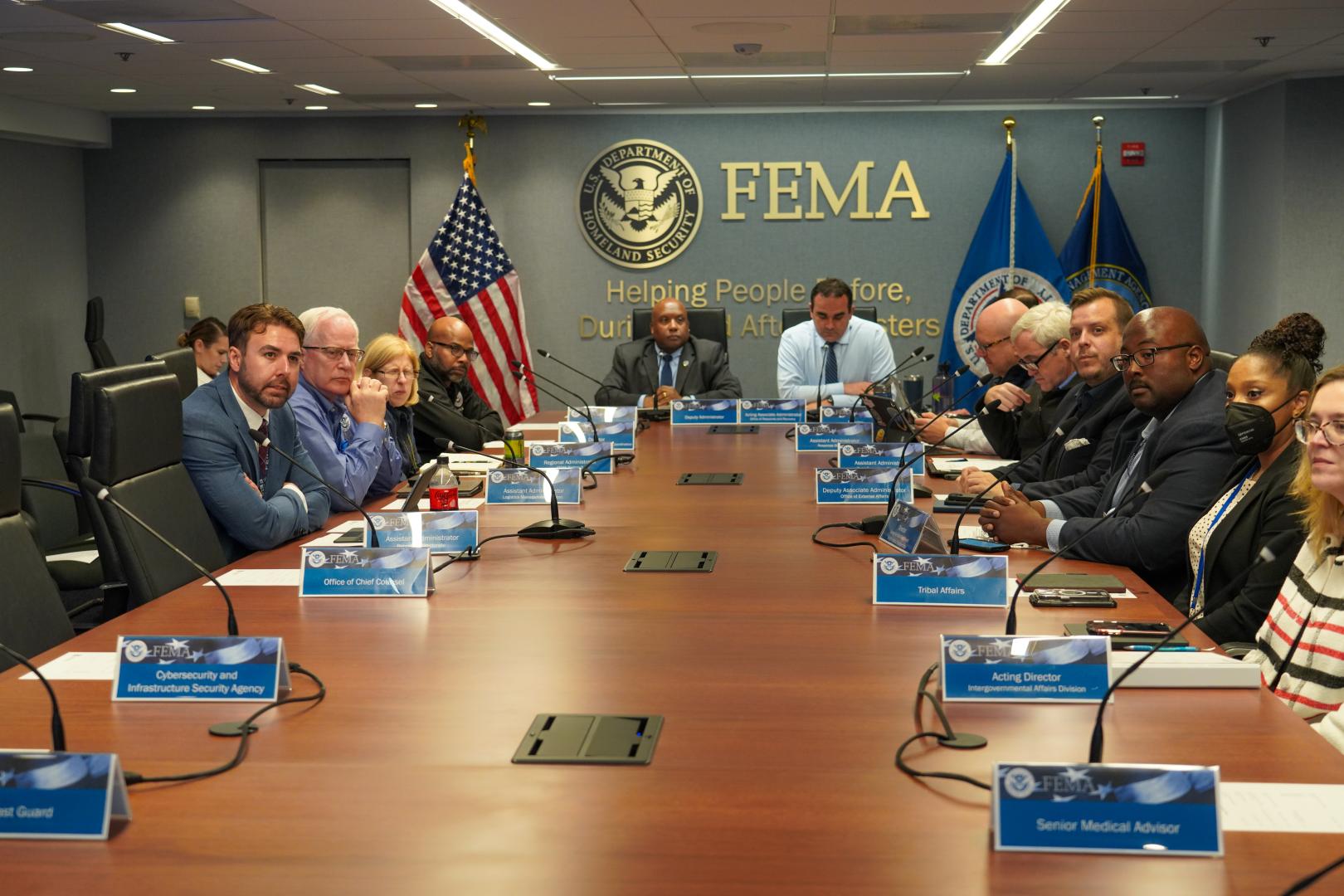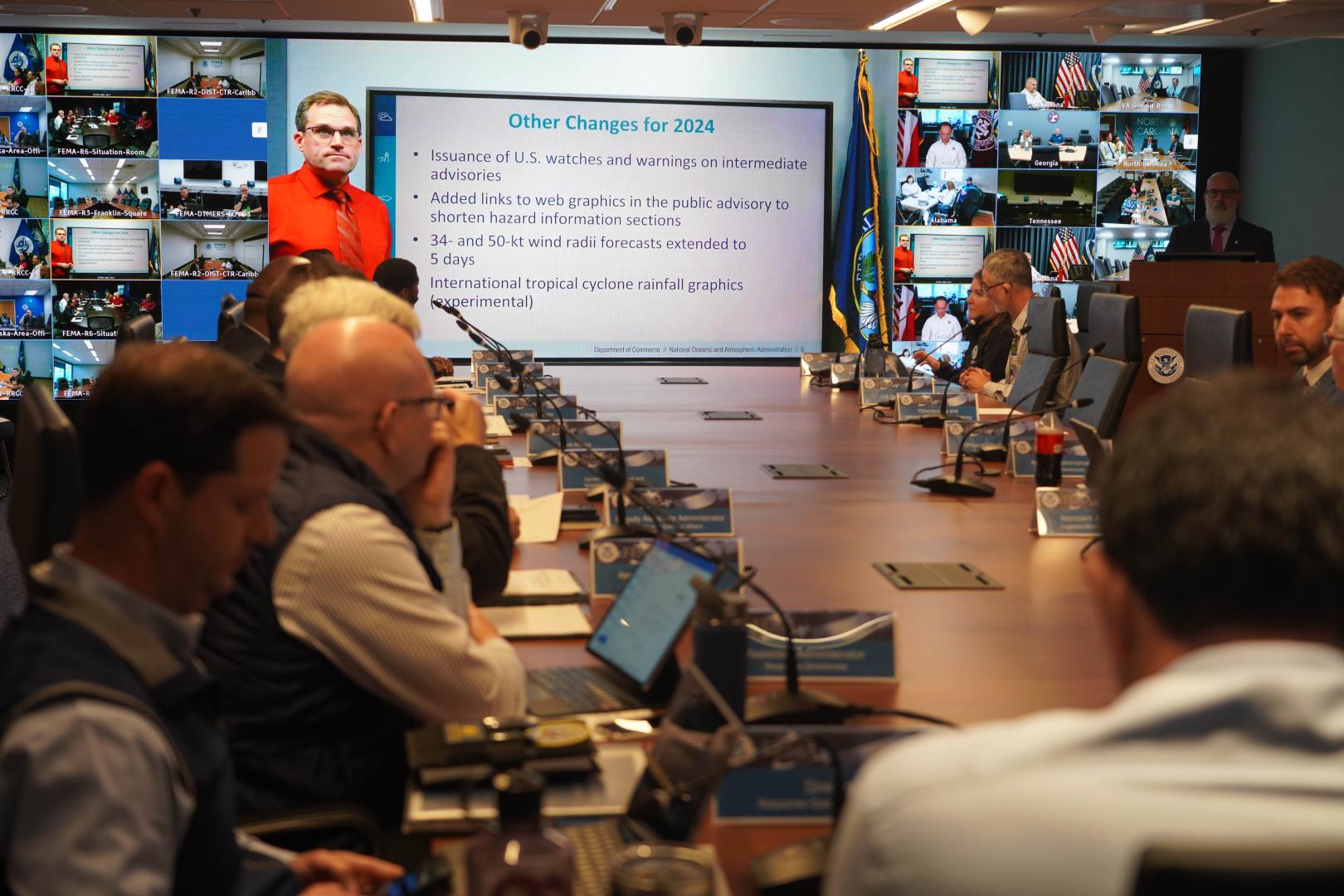Throughout the year, FEMA works to build resilience in communities and prepare the nation for hurricanes. These actions are particularly important at the start of the Atlantic and Pacific hurricane seasons. On May 23, the agency hosted our annual video teleconference (VTC) focused on FEMA’s posture and readiness. The conference is an opportunity for FEMA regions and agency leaders to collaborate, plan and prepare.
We sat down with two FEMA employees who play an essential role in the VTC and in the agency’s hurricane preparedness. Intergovernmental Affairs Specialist Jeremy Bott supports information distribution during emergencies and Threat Monitoring Team Section Chief Matthew Arant works within the National Watch Center. Both individuals help leaders, at every level of response, with situational awareness and decision-making during disasters.

What do you do year-round to prepare the agency for hurricane season?
Jeremy Bott:
I provide technical expertise on hurricane preparedness and disaster-specific messaging to national level emergency management associations, state, Tribal Nations, territorial and local stakeholders.
Matthew Arant:
I collaborate closely with the National Hurricane Center and FEMA Liaison Officers within the Hurricane Liaison Team (HLT) based in Miami. During the offseason, I actively participate in training courses led by the HLT to enhance both my own preparedness and that of the National Watch Center (NWC) Team for the upcoming hurricane season. The National Watch Center consistently evaluates notification and reporting procedures to ensure that FEMA leadership is promptly and accurately informed, enabling them to make well-informed decisions regarding preparation and response to potential hurricane-induced disasters.
What is the purpose of the Hurricane video teleconference?
Jeremy Bott:
To bring together state, Tribal Nation and territorial partners with federal emergency management senior leadership to discuss readiness/preparedness actions, lessons learned and inform of any unmet needs prior to June 1 start of the Atlantic hurricane season.
Matthew Arant:
The primary intent of the FEMA-led Hurricane Readiness VTC is to provide an opportunity for select state, tribal, and territorial Emergency Managers to engage in a pre-season briefing conducted by the National Hurricane Center. Additionally, it serves as a platform for coastal emergency management professionals to exchange valuable insights and lessons learned from past experiences, with the goal of enhancing preparedness for the upcoming hurricane season.
How does the Hurricane VTC help position FEMA ahead of hurricane season?
Jeremy Bott:
It helps to determine needs before tropical systems strike, and it shows FEMA’s partners we are committed and steadfast in supporting their needs.
Matthew Arant:
The Hurricane Readiness VTC will provide FEMA with valuable insights into the severity of the upcoming hurricane season, using information provided from the Hurricane Center's seasonal outlook. This collaboration with coastal emergency managers allows FEMA leaders to assess the preparedness levels of each state for a potential hurricane, enabling them to anticipate the necessary levels of federal assistance.
What are some key takeaways of this year’s VTC?
Jeremy Bott:
Climate change is causing an earlier start and ending to the hurricane season, warming waters and climate patterns are creating rapid strengthening of storms. This will be the first season with the new Individual Assistance Equity Rules changes, which will provide survivors with more access to benefits.
Matthew Arant:
I have a deep appreciation for the expertise and capabilities of our colleagues at the National Hurricane Center and FEMA's Hurricane Liaison Team. I have full confidence in the accuracy and reliability of the information they provide for both short and long-term forecasting. However, Mother Nature and natural disasters can be very unpredictable. Through my experience working with FEMA, I have learned the value of preparing for worst-case scenarios. Our agency's primary mission is helping individuals in need; we are committed to fulfilling that duty in any situation that may arise.

What is FEMA doing to prepare for this year’s hurricane season?
Jeremy Bott:
The agency’s office of external affairs is hosting communications campaign at the national and regional levels, helping educate our partners and the public on hurricane preparedness. We are also holding trainings and exercises throughout the spring to help ensure emergency managers are ready.
Matthew Arant:
The FEMA National Watch Center is committed to enhancing operational efficiency in order to promptly disseminate information to key stakeholders such as FEMA, DHS, the National Security Council and other interagency partners. Within the National Watch Center, the Threat Monitoring Team will be responsible for identifying, monitoring and reporting on potential vulnerabilities to critical infrastructure posed by storm systems.
What are some steps leaders in a community can take to help prepare others for hurricane season?
Jeremy Bott:
Community leaders can work closely with local, state and federal emergency managers to get preparedness messages out. The time to prepare is before the storm. Encourage whole-of-community collaboration throughout the year.
Matthew Arant:
They should maintain ongoing collaborative partnerships within the emergency management community as effective preparation relies on sharing information. The Hurricane Readiness VTC serves as a crucial platform for facilitating information exchange among local, state and federal emergency managers. This platform emphasizes the importance of proactive preparedness in anticipation of approaching storms.
What are some simple steps people can take to prepare for the hurricane season?
Jeremy Bott:
You should assess your family’s needs to evacuate or shelter in place, have a plan in place and communicate your plan with friends and family. If you have questions on how to prepare, visit Ready.gov.
Matthew Arant:
Communities in high-risk areas should assess their needs and regularly practice evacuation plans. It is crucial for individuals in high-risk areas to reach out to their local emergency managers for guidance on evacuation plans or visit Evacuation | Ready.gov for additional resources.
Additionally, there is a wealth of forecast information accessible to the public. It is imperative to stay informed by monitoring updates from traditional media outlets, social media platforms and local alert notifications. Prioritizing safety by taking necessary precautions to protect oneself, family and friends is of utmost importance.
You can download the FEMA App: Take Charge of Disasters | Ready.gov or visit Emergency Alerts | Ready.gov for more information on how to stay informed throughout hurricane season.

